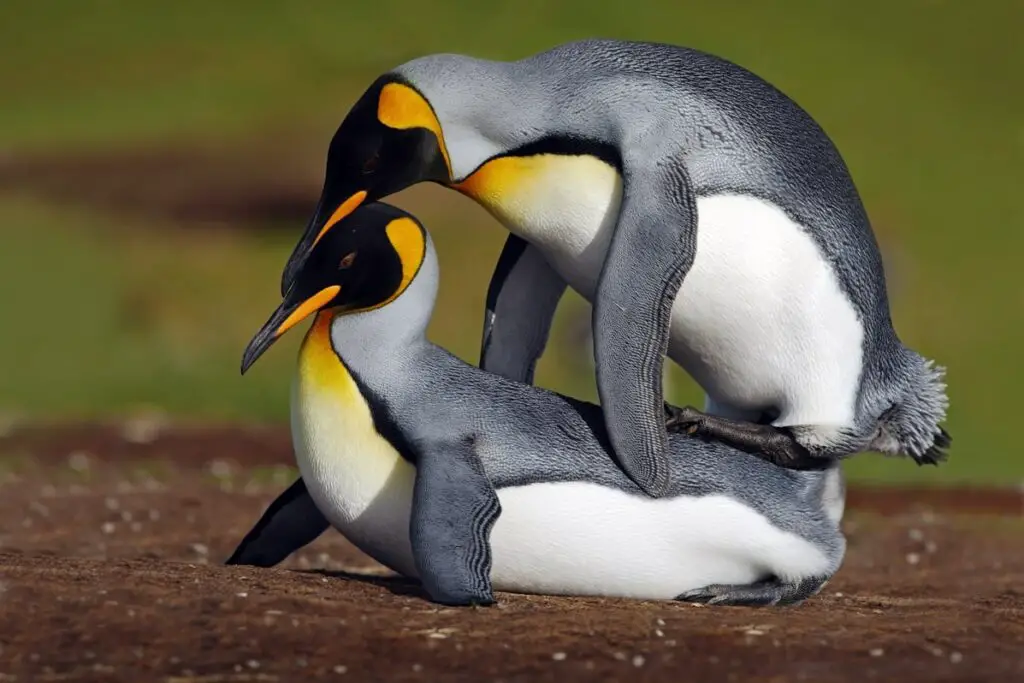Penguins are flightless birds that spend their lives in the ocean and on land. While they cannot fly through the air, they can swim through the water as though they are flying. In complete contrast to their grace underwater, penguins move on land in an awkward waddle.
The eighteen extant penguin species are primarily in the Southern Hemisphere except for the Galapagos Penguins, which live in the Galapagos Islands, just north of the Equator. Many of these species live in very different climates and exhibit different breeding strategies.
Of the eighteen penguin species, some, like the Emperor Penguin, are only seasonally monogamous, which means they pair up for one breeding season to raise their young. Only about fifteen percent of these mated pairs breed together the following year.
Most penguin species, however, exhibit more permanent mating bonds, and a high percentage of penguin pairs breed together year after year. Many penguins mate for life even though they may only spend one month together out of the whole year.
The Emperor Penguin swims long distances, sometimes thousands of miles, between breeding seasons while foraging for food. If the mated pair do not return to the breeding grounds simultaneously, they usually mate with other individuals.
The Southern Rockhopper Penguin is similar to the Emperor Penguin and swims long distances between breeding seasons. Unlike the Emperor Penguin, most Southern Rockhopper penguins mate for life.

When Do Penguins Mate?
Some penguins mate in the spring and early summer, the coldest time of the year in the Southern Hemisphere. The conditions can be harsh, with low temperatures during the beginning of the breeding season for Antarctic penguins like the Emperor and King penguins.
Some Antarctic penguins, like the Chinstrap Penguin, breed in mid to late autumn on ice-free coastlines of Antarctica and its surrounding islands.
Other species, like the Galapagos Penguin, breed year-round and produce up to two or three broods annually during the right conditions when they have sufficient food to feed their young. The best breeding conditions usually occur during the spring and fall.
How Do Penguins Mate?
Penguin species have developed various methods of courting. These courting methods involve head shaking, trumpeting, and wing flapping. In some courtship rituals, only the males display to females. In some species, both females and males display together.
Some penguin species build nests out of pebbles, building up a mound with stones they find on the rocky shorelines where they nest in large colonies. Part of the courtship for some of these species, like Gentoo Penguins, involves males giving a pebble to entice females.
Once a female selects a mate, they construct a nest together, and the female lays her eggs. The number of eggs laid is species-dependent.
While some species build nests of stones like Gentoo and Adelie penguins, some nest in burrows like Little Penguins, and others nest in volcanic cracks like Galapagos Penguins. The King and Emperor penguins do not build nests; instead, they incubate eggs on their feet.
Also Read: Do Penguins Have Knees?
How Often Do Penguins Mate?
Penguins’ breeding and mating strategies are highly variable and dependent on the species. Even within species, there is some fluidity in how often penguins mate. Most species, however, form large colonies annually during their primary breeding season.
The largest penguins, Emperor and King penguins, have the longest breeding seasons. The Emperor Penguin breeds in the winter, and their young become mature and independent during the summer, five to six months later.
King Penguins have the longest breeding season, lasting between fourteen and sixteen months. Female King Penguins may only produce one chick every other year because of the timing.
Little Penguins are one of the smallest penguins and have the shortest breeding season, lasting less than two months. Like other penguins that live in temperate climates, Little Penguins breed multiple times throughout the year in the right conditions.
What Happens if a Penguin Loses Its Mate?
No research has yet observed penguins mourning the loss of a mate. In most penguin species, mates separate at the end of the breeding season and do not see each other again until the following season.
If one member of the mating pair fails to arrive at the breeding grounds on time, the remaining bird usually mates with a different unmated bird.
Emperor and King penguins incubate their eggs and wait for their partners to return from foraging to help care for them. The males abandon the eggs if the females do not return in time. The male bird will have to stop incubating and find food.
While Emperor Penguins do not seem to mourn the loss of their mate, they will miss the loss of their egg or chick. If an Emperor Penguin loses their egg or chick while they are foraging, it will attempt to kidnap one from another pair upon its return.
Researchers believe chick kidnapping results from a penguin’s hormonal drive to raise a chick. This parental hormone helps ensure that the penguin chick’s parents return to the breeding colony from foraging trips and drives their behavior.
Also Read: Where Do Penguins Live?
Do Penguins Mate With Other Species?
Sometimes, penguins mate with other species, producing hybrid offspring. The offspring from the crossbreeding result in birds that usually cannot reproduce. However, if the two species are closely related, they can produce viable offspring.
The seven penguin species in the Eudyptes genus are closely related, and some crossbreed with each other. The hybrid offspring that result from these matings can usually reproduce.
